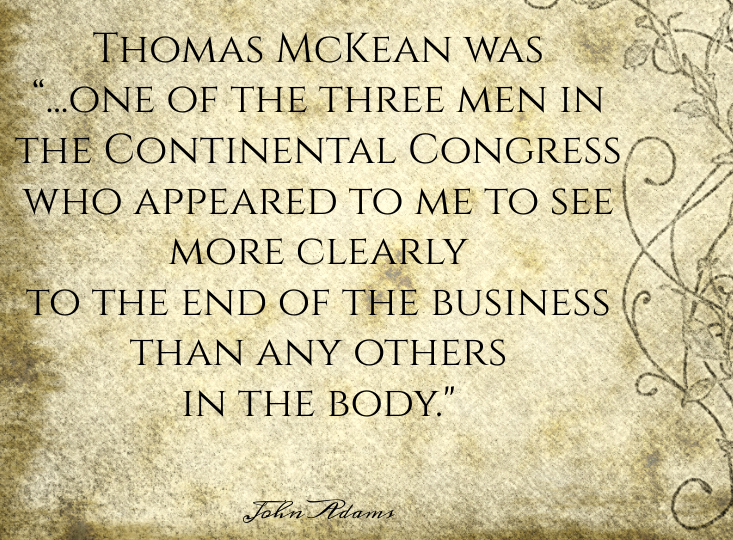Mark Cole
Thomas McKean was born in 1734, the son of Irish immigrants. Like George Read, Thomas McKean was tutored by the Reverend Doctor Francis Allison in Latin, Greek, history, and moral philosophy before studying law and entering the bar at the age of 21.
Throughout his adult life, McKean was a recognizable figure: he always wore a large cocked hat and carried a gold-headed cane. He stood over six feet tall. Portraits of him could easily be mistaken for George Washington by a casual observer.
McKean was a man of quick temper, vigorous personality, tremendous intellect, and lofty ambition. As such, he was often the center of controversy. Some thought of him as cold, proud and vain, and it is certainly true that he was not overly gregarious. But, his credentials and intellect were never in question and because of his many outstanding qualities, McKean always had plenty of work to do.
At various times in his long and interesting life, Thomas McKean held scores of municipal and county offices, as well as the major offices of member of the Stamp Act Congress and Continental Congress from Delaware, President of the Continental Congress under the Articles of Confederation, Speaker of the Delaware House, and chief executive (called “President” then) of Delaware.
During the Revolution, McKean was an officer in the Continental Army and had to move five times in order to stay ahead of the marauding British Army.
That would be enough for most men. But the rest of the story is that McKean’s responsibilities in Delaware constituted only the first half of his career.
After the colonies declared their independence (with McKean signing the Declaration as a member of the Continental Congress), McKean also became the Chief Justice of…Pennsylvania. In fact, in 1777, he was simultaneously the Chief Justice of Pennsylvania and the President of Delaware!
After serving as Pennsylvania’s Chief Justice for 22 years (during which time he was also a delegate to the Pennsylvania convention which ratified the U.S. Constitution), he became the Governor of Pennsylvania for 9 years. He left that office in 1808, but didn’t exactly retire. At the age of 80, former Governor McKean led a Philadelphia citizens group and helped organize a strong defense during the War of 1812.
It is generally believed that no American has ever held the number of offices in two different states that McKean held.
Oh, and along the way, he was a father of ten. He had six children with his first wife, who died in 1773. He married again, and had four more children with his second wife.
He finally died when he was 84 years old, in 1817.
The eminent John Adams, writing about those momentous days in the summer of 1776, summarized what he observed about McKean during the proceedings leading up to the Declaration of Independence. But Adams’ observation could apply to the whole of McKean’s life, as well. He wrote that McKean was “one of the three men in the Continental Congress who appeared to me to see more clearly to the end of the business than any others in the body.”
Check out Mark’s book:
Lives, Fortunes, Sacred Honor: The Men Who Signed the Declaration of Independence














